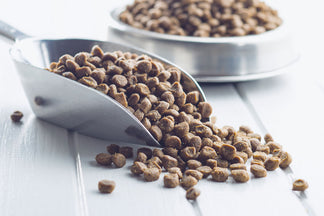I often wonder why we have such a massive pet obesity problem in this country. As you would suspect, the answer isn't maliciousness or lack of caring, but rather, general misinformation (and a little laziness)! Let's break this out:
- It isn't because we don’t care about the health and well being of our pets and would prefer that they live shorter lives.
- It isn't because we don’t care about the extra money we pay for food, medicine, vet visits and surgeries due to having overweight pets (especially in this economy)!
- It probably has something to do with us being a little lazy and not wanting to properly exercise our pets.
Without question, on a national level, we are feeding our dogs and cats more food than they need to be healthy. Why is this? For a possible answer, let’s take a look at the primary source of feeding instructions for most pet owners: the label on the pet food itself.
When was the last time that you really looked at your pet food label? I know, it’s intimidating. The ingredient lists alone are confusing and require a PhD to interpret. Setting aside the challenges with the ingredients for now, let’s consider the feeding instructions.
You said feed ‘em how much?
I don’t know if everyone looks at the feeding instructions on their pet food label, but I would assume that most have looked at the label at least once, if not from time to time, in order to get an idea about how much to feed their pet. And, perhaps, that’s where the problem lies. You see, the feeding instructions on most food labels are essentially worthless! I will use an example to illustrate my point.
Let’s assume that we have two dogs. The first dog is an inactive, 4 year old Dalmatian that weighs 60 lbs. and the second dog is an active, 4 year old Labrador Retriever, also weighing 60 lbs. The Dalmatian is overweight- their normal weight range is around 50-55. The Lab is on the lighter side as they normally fall into the 60-85 lb. range. The Dalmatian should be fed no more than ~ 950 kcals per day assuming that their optimal weight is 53 lbs. The Lab should be fed ~ 1,250 kcals per day assuming that their optimal weight is 65 lbs. Now let’s look at the feeding instructions of two premium canned dog food brands.
Canidae Brand Grain Free- 416 kcal per can (13 oz)
According to the label: “If feeding solely, feed one 13 Oz. can for every 20 lbs. of dog’s body weight.”
So let’s do the math. According to the label, we would feed both dogs the exact same amount- 3 cans per day- which translates into 1248 kcals per day. Common sense tells you that the Lab should be fed more than the Dalmatian– but you have no way of knowing how to adjust the recommendations. Although the Lab seems to be fed the correct amount the Dalmatian is getting an extra 300 kcals per day that he doesn’t need and is well on his way to obesity. No wonder why 53% of our dogs and 58% of our cats have weight problems.
Let’s try another label, this time from Innova: Innova Senior Adult= 397 kcals per can (13.2 oz)
According to the label: “Feed 3/4 to 1 1/4 cans per 15 lbs. of body weight per day. At least Innova provides a range suggesting that the amount to feed can vary! But how would you really know which to apply to your situation?
Let’s do the math, this time using the endpoints of the suggested range.
First of all, we need 4 servings (60/15 = 4) of 3/4 to 1 1/4 cans. So we would be feeding our dogs between 3 to 5 cans per day. That translates to 1,191 to 1,985 kcals per day. Oh oh. Odds are good that we would be over feeding BOTH of our example dogs!
I think it’s pretty clear that you can’t rely on the food label to provide you with an accurate estimate of how much to feed your pet. The recommendation is either too generic or flat out too much
More Problems
Ours was a simple case assuming that the pets were only fed one food, in this case canned. What happens when you mix in dry food, as many do, and treats as almost everyone does? Crap! Now we need a calculator. And we still don’t know the proper serving size for any of our foods. Further, what happens when you switch foods? You can’t just assume that you should feed the same amount because the kcals can be different.
In our example, a can of Canidae has 19 kcals more than a can of Innova. If you fed your dog 4 cans of Innova and then switched and started feeding 4 cans per day of the Canidae, you would be adding an extra 76 kcals per day. That translates into an extra ~28,000 kcals per year or, if not exercised off, about 8 lbs. per year. Remember that 8 lbs is a lot: for dogs weighting around 60 lbs, as in our example, it is equal to 13% of body weight.
Is it any wonder that we have a pet obesity epidemic in this country?
Don’t misunderstand my intent for writing this piece. I am not blaming the pet food companies for this. It would be difficult for them to create labels with specific feeding instructions for each pet owners individual circumstance. Rather, I am pointing out that pet owners need to learn how many calories their dog or cat needs each day and recognize that this can change based on the pets activity and age.

 Food
Food
 Food
Food
 Food
Food
